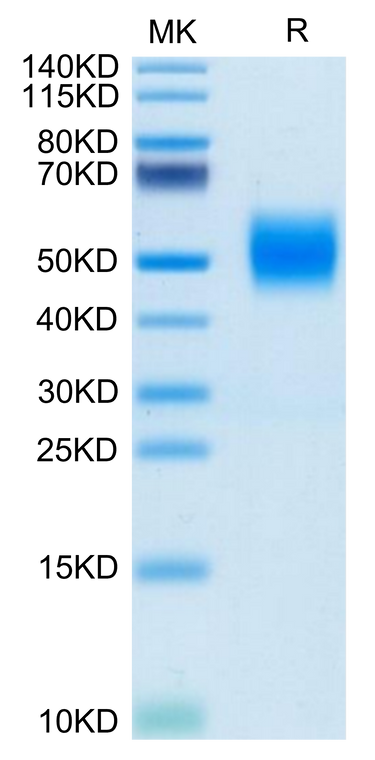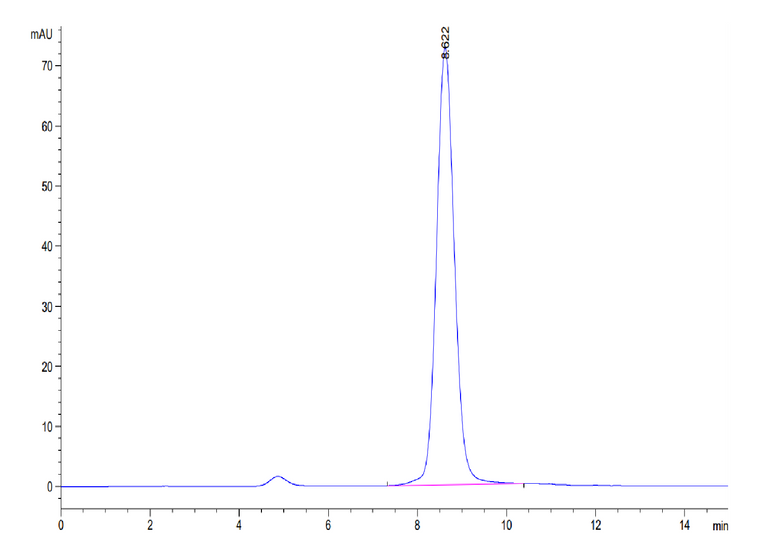| Host: |
HEK293 |
| Note: |
STRICTLY FOR FURTHER RESEARCH USE ONLY (RUO). MUST NOT TO BE USED IN DIAGNOSTIC OR THERAPEUTIC APPLICATIONS. |
| Short Description: |
Recombinant-Human FGFR2 beta (IIIc)-C-His-Avi protein was developed from hek293 and has a target region of C-His-Avi. For use in research applications. |
| Conjugation: |
Biotin |
| Formulation: |
Lyophilised from 0.2 µm filtered PBS solution pH7.4. |
| Dilution Range: |
Upon receipt centrifuge vial to ensure maximal product extraction, recommended: 20sec, 5K RPM |
| Storage Instruction: |
The lyophilized protein is stable for at least 1 year from date of receipt at-20°C. |
| Endotoxin: |
Endotoxin content was assayed using a LAL gel clot method. Endotoxin level was found to be less than 0.1 ng/µg (1EU/µg). |
| Gene Symbol: |
FGFR2 |
| Gene ID: |
2263 |
| Uniprot ID: |
FGFR2_HUMAN |
| Immunogen Region: |
Arg152-Glu377 |
| Immunogen: |
DNA sequence encoding Human FGFR2 beta (IIIc) including a C-His-Avi tag was expressed in HEK293 Cells. The recombinant protein was then biotinylated site specific using the AVItag biotinylation technology. |
| Function | Tyrosine-protein kinase that acts as cell-surface receptor for fibroblast growth factors and plays an essential role in the regulation of cell proliferation, differentiation, migration and apoptosis, and in the regulation of embryonic development. Required for normal embryonic patterning, trophoblast function, limb bud development, lung morphogenesis, osteogenesis and skin development. Plays an essential role in the regulation of osteoblast differentiation, proliferation and apoptosis, and is required for normal skeleton development. Promotes cell proliferation in keratinocytes and immature osteoblasts, but promotes apoptosis in differentiated osteoblasts. Phosphorylates PLCG1, FRS2 and PAK4. Ligand binding leads to the activation of several signaling cascades. Activation of PLCG1 leads to the production of the cellular signaling molecules diacylglycerol and inositol 1,4,5-trisphosphate. Phosphorylation of FRS2 triggers recruitment of GRB2, GAB1, PIK3R1 and SOS1, and mediates activation of RAS, MAPK1/ERK2, MAPK3/ERK1 and the MAP kinase signaling pathway, as well as of the AKT1 signaling pathway. FGFR2 signaling is down-regulated by ubiquitination, internalization and degradation. Mutations that lead to constitutive kinase activation or impair normal FGFR2 maturation, internalization and degradation lead to aberrant signaling. Over-expressed FGFR2 promotes activation of STAT1. |
| Protein Name | Fibroblast Growth Factor Receptor 2Fgfr-2K-SamKgfrKeratinocyte Growth Factor ReceptorCd Antigen Cd332 |
| Database Links | Reactome: R-HSA-109704Reactome: R-HSA-1257604Reactome: R-HSA-190375Reactome: R-HSA-190377Reactome: R-HSA-2023837Reactome: R-HSA-2033519Reactome: R-HSA-2219530Reactome: R-HSA-5654221Reactome: R-HSA-5654695Reactome: R-HSA-5654699Reactome: R-HSA-5654700Reactome: R-HSA-5654727Reactome: R-HSA-5655253Reactome: R-HSA-5673001Reactome: R-HSA-6811558Reactome: R-HSA-8851708Reactome: R-HSA-8853333 |
| Cellular Localisation | Cell MembraneSingle-Pass Type I Membrane ProteinGolgi ApparatusCytoplasmic VesicleDetected On Osteoblast Plasma Membrane Lipid RaftsAfter Ligand BindingThe Activated Receptor Is Rapidly Internalized And DegradedIsoform 1: Cell MembraneIsoform 3: Cell MembraneIsoform 8: SecretedIsoform 13: Secreted |
| Alternative Protein Names | Fibroblast Growth Factor Receptor 2 proteinFgfr-2 proteinK-Sam proteinKgfr proteinKeratinocyte Growth Factor Receptor proteinCd Antigen Cd332 proteinFGFR2 proteinBEK proteinKGFR proteinKSAM protein |
Information sourced from Uniprot.org
12 months for antibodies. 6 months for ELISA Kits. Please see website T&Cs for further guidance








